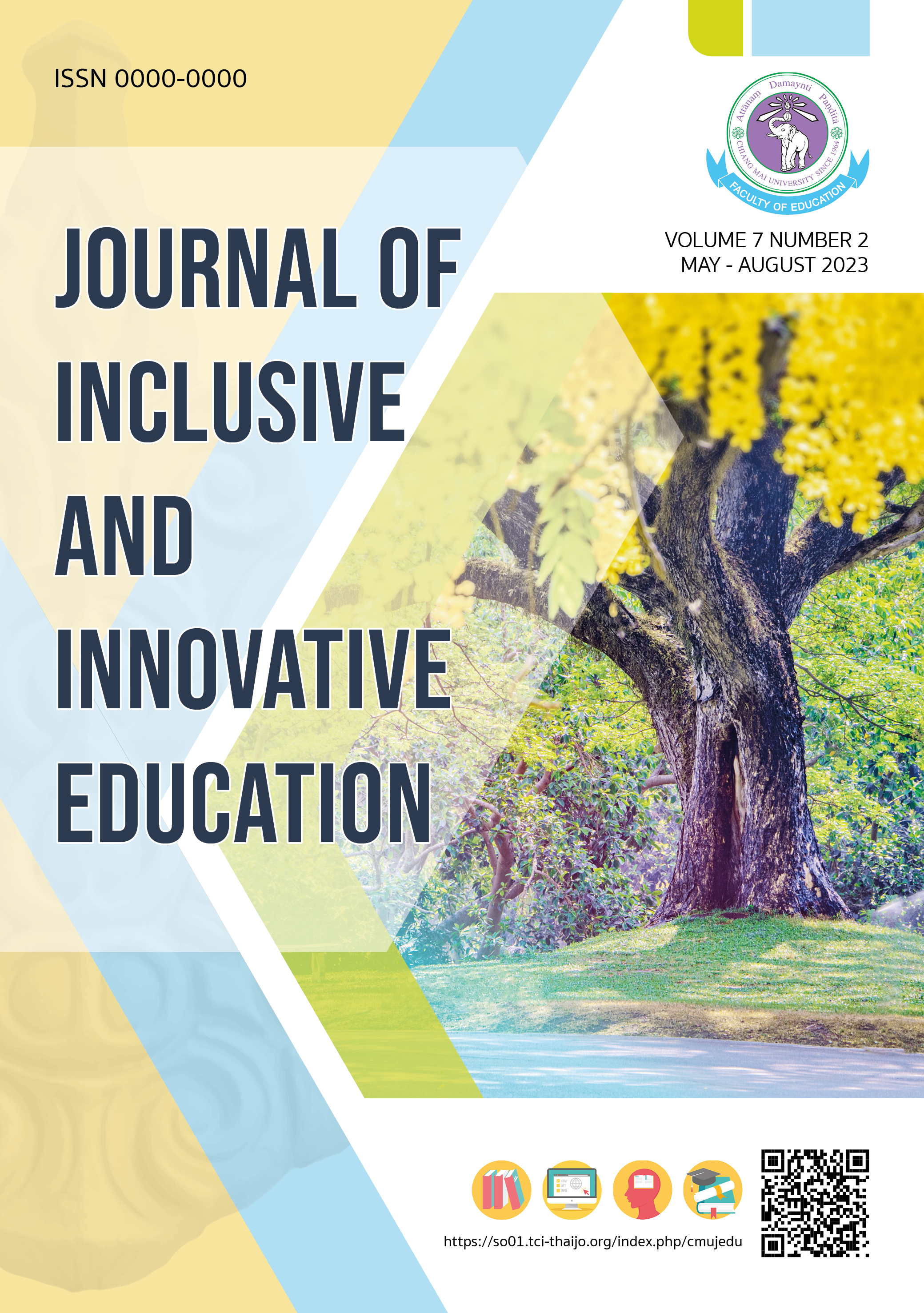ผลการจัดกิจกรรมการเล่นสื่อวัสดุปลายเปิดที่มีต่อทักษะความสัมพันธ์ของเด็กปฐมวัย
Main Article Content
บทคัดย่อ
การศึกษาครั้งนี้มีวัตถุประสงค์เพื่อศึกษาผลการจัดกิจกรรมการเล่นสื่อวัสดุปลายเปิดที่มีต่อทักษะความสัมพันธ์ของเด็กปฐมวัย กลุ่มเป้าหมาย คือ เด็กปฐมวัยชาย-หญิง อายุระหว่าง 3-4 ปี กำลังศึกษาอยู่ในระดับชั้นอนุบาลปีที่ 1 ภาคเรียนที่ 2 ปีการศึกษา 2565 โรงเรียนสาธิตมหาวิทยาลัยรามคำแหง (ฝ่ายประถม) สังกัดกระทรวงการอุดมศึกษา วิทยาศาสตร์ วิจัยและนวัตกรรม จำนวน 24 คน เครื่องมือที่ใช้ในการศึกษา ได้แก่ 1) แผนการจัดกิจกรรมการเล่นสื่อวัสดุปลายเปิด จำนวน 12 แผน โดยจัดกิจกรรมการเล่นสื่อวัสดุปลายเปิดในช่วงกิจกรรมเสรี 2) แบบสังเกตพฤติกรรมทักษะความสัมพันธ์ของเด็กปฐมวัย วิเคราะห์ข้อมูลเชิงปริมาณโดยใช้ค่าเฉลี่ย ส่วนเบี่ยงเบนมาตรฐาน และวิเคราะห์ข้อมูลเชิงคุณภาพโดยการวิเคราะห์เชิงเนื้อหา ผลการศึกษา พบว่า เด็กปฐมวัยมีคะแนนเฉลี่ยทักษะความสัมพันธ์ก่อนได้รับการจัดกิจกรรมการเล่นสื่อวัสดุปลายเปิดเท่ากับ 22.71 คะแนน และส่วนเบี่ยงเบนมาตรฐานเท่ากับ 4.18 คะแนน และหลังได้รับการจัดกิจกรรมมีคะแนนฉลี่ยทักษะความสัมพันธ์ของเด็กปฐมวัย เท่ากับ 33.75 คะแนน และส่วนเบี่ยงเบนมาตรฐานเท่ากับ 2.66 คะแนน กล่าวคือ เด็กปฐมวัยมีทักษะความสัมพันธ์สูงกว่าก่อนการจัดกิจกรรมการเล่นสื่อวัสดุปลายเปิด ด้านที่มีคะแนนเฉลี่ยมากที่สุด คือ ทักษะความสัมพันธ์ระหว่างเด็กกับเด็ก มีคะแนนเฉลี่ยเท่ากับ 16.92 คะแนน และส่วนเบี่ยงเบนมาตรฐานเท่ากับ 1.28 คะแนน และด้านที่รองลงมา คือ ทักษะความสัมพันธ์ระหว่างเด็กกับผู้ใหญ่ มีคะแนนเฉลี่ยเท่ากับ 16.83 คะแนน และส่วนเบี่ยงเบนมาตรฐานเท่ากับ 1.46 คะแนน
Article Details

อนุญาตภายใต้เงื่อนไข Creative Commons Attribution-NonCommercial-NoDerivatives 4.0 International License.
หากผู้เสนอบทความมีความจำเป็นเร่งด่วนในการตีพิมพ์โปรดส่งลงตีพิมพ์ในวารสารฉบับอื่นแทน โดยกองบรรณาธิการจะไม่รับบทความหากผู้เสนอบทความไม่ปฏิบัติตามเงื่อนไขและขั้นตอนที่กำหนดอย่างเคร่งครัด ข้อมูลของเนื้อหาในบทความถือเป็นลิขสิทธิ์ของ Journal of Inclusive and Innovative Education คณะศึกษาศาสตร์ มหาวิทยาลัยเชียงใหม่
เอกสารอ้างอิง
Aperture Education. (2021). DESSA Strategies Guide: Relationship Skills. Retrieved from https://f.hubspotusercontent30.net/hubfs/2613587/Guides%20-%20BTSG,%20SSG/Aperture%208%20Guide_2021.pdf?hsCtaTracking=7280d604-fc2d-4f36-b3a8-13e2539ea7d0%7C7e4cfb29-8edc-4f3d-aadf-791a9feb1d4c.
Australian Children’s Education & Care Quality Authority. (2016). Relationships With Children. Retrieved from
Bowornwattanaset, C. (2016). Instructional Strategies Based on Scaffolding Theory. Prae-wa Kalasin Journal of Kalasin University, 3(2), 154-179.[in Thai]
Bureau of Academic Affairs and Educational Standards, Office of the Basic Education Commission &Ministry of Education of Thailand. (2022). Guidelines for resolving the effects of recession on early childhood development and learning. n.d.[in Thai]
CASEL. (2022). Relationship Skills. Retrieved from https://casel.org/fundamentals-of-sel/what-is-the-casel-framework/#relationship.
Casey and Robertson. (2019). Loose Parts Play. Retrieved from https://www.inspiringscotland.org.uk/wp-content/uploads/2020/09/Loose-Parts-Play-Toolkit-2019-web.pdf.
Division of Early Learning Florida Department of Education. (2017). Social and Emotional Development. Retrieved from http://flbt5.floridaearlylearning.com/standards.html#a=two_year_olds,three_year_olds,four_year_olds.
Equitable Education Research Institute (EEFI). (2022). Learning Loss. Retrieved from https://research.eef.or.th/learning-loss-recession/.[in Thai]
Flannigan, C. and Dietze, B. (2017). Children, Outdoor Play, and Loose Parts. Journal of Childhood Studies, 42(4), 53-60.
Illinois Early Learning and Development Standards. (2013). Illinois Early Learning and Development Standards. Retrieved from https://illinoisearlylearning.org/wp-content/uploads/2017/02/ields.pd.
Hemchayart, W. et al. (2022). Documentation of Loose Parts Workshop : The Miracle of Creative Thinking in the 21st Century on March 12, 2022. Retrieved from https://anyflip.com/cymfb/glyt/basic.[in Thai]
Junlasak, S., Hemchayart, W. (2021). Parents’ Roles in Promoting Loose Parts Play in the Loose Parts Kits Project. An Online Journal of Education, 17(2), 1-14.[in Thai]
Khayankij, S. and Pittayapitak, T. (2021). Loose parts play to promote creative thinking in young children. Retrieved from http://www.curativethailand.com/pdfbook/%E0%B8%84%E0%B8%B9%E0%B9%88%E0%B8%A1%E0%B8%B7%E0%B8%AD%20%E2%80%9C%E0%B8%AA%E0%B8%B7%E0%B9%88%E0%B8%AD%20%E0%B9%80%E0%B8%A5%E0%B9%88%E0%B8%99%20%E0%B8%AA%E0%B8%A3%E0%B9%89%E0%B8%B2%E0%B8%87%E2%80%9D%E0%B9%80%E0%B8%9E%E0%B8%B7%E0%B9%88%E0%B8%AD%E0%B8%9E%E0%B8%B1%E0%B8%92%E0%B8%99%E0%B8%B2%E0%B8%81%E0%B8%B2%E0%B8%A3%E0%B8%84%E0%B8%B4%E0%B8%94%E0%B8%82%E0%B8%AD%E0%B8%87%E0%B9%80%E0%B8%94%E0%B9%87%E0%B8%81%E0%B8%9B%E0%B8%90%E0%B8%A1%E0%B8%A7%E0%B8%B1%E0%B8%A2.pdf. [in Thai]
Klintavorn, W. (2020). The Effect of Using Story to Enhance Life Skills of Young Children Lampang Primary Education Service Area Office1. Journal of Inclusive and Innovative Education, 4(3), 93-105.[in Thai]
Ministry of Education of Thailand. (2017). The Early Childhood Curriculum B.E. 2560 (A.D. 2017). Bangkok: Teachers Council of Thailand Printing House Ladprao.[in Thai]
Ministry of Education Republic of Singapore. (2013). Nurturing Early Learners A Curriculum for Kindergartens in Singapore: Social and Emotional Development. Ministry of Education: Republic of Singapore.
Nicholson, S. (1972). How Not to Cheat Children The Theory of Loose Parts. Retrieved from https://media.kaboom.org/docs/documents/pdf/ip/Imagination-Playground-Theory-of-Loose-Parts-Simon-Nicholson.pdf.
Parsook, N. et al. (2022). Effect of Using Inquiry Approach and Social Constructivism on Social Studies Learning Achievement and Problem Solving Ability of Mathayomsuksa Two Students. Journal of Inclusive and Innovative Education, 6(3), 72-86.[in Thai]
Pinyoanuntapong, S. (2007). Research on Early Childhood Education. Bangkok: Suan Dusit University.[in Thai]
Play Scotland. (2020). Playful Schools: The power of Loose Parts Play. Retrieved from https://www.playscotland.org/resources/print/PS0025-Play-Scotland-Playful-Schools-Report-2.pdf?plsctml_id=20352.
Rangdaeng, M. et. al. (2022). Provision of Learning Experiences Integrated in PhysicSubject Matter by Using the Engineering Design Process on Science Skills of Young Children. Journal of Inclusive and Innovative Education, 6(3), 131-145.[in Thai]
Spencer, R, A. et al. (2019). Educator perceptions on the benefits and challenges of loose parts play in the outdoor environments of childcare centres. AIMS Public Health. 6(4), 461-476.
Sutthiboon, P. and Khayankij, S. (2022). Effects of Organizing Guided Play Activities and Outdoor Loose Parts Towards Collaborative Play Behaviors of Kindergarteners. An Online Journal of Education, 17(1), 1-14.[in Thai]
Taxas Education Agency. (2022). 2022 TEXAS Prekindergarten Guidelines PK3 and PK4 Comprehensive Guide. Retrieved from https://tea.texas.gov/academics/early-childhood-education/2022-texas-pkg-comprehensive-guide.pdf.
The Massachusetts Department of Early Education and Care, et.al. (2015). Massachusetts Standards for Preschool and Kindergarten Social and Emotional Learning, and Approaches to Play and Learning. Retrieved from https://www.dy-regional.k12.ma.us/sites/g/files/vyhlif4331/f/uploads/sel-apl-standards_2015.pdf.
Wongaree, S. (2016). Documentation of Psychology for Teachers. UdonThani: Faculty of Education, UdonThani Rajabhat University.[in Thai]


